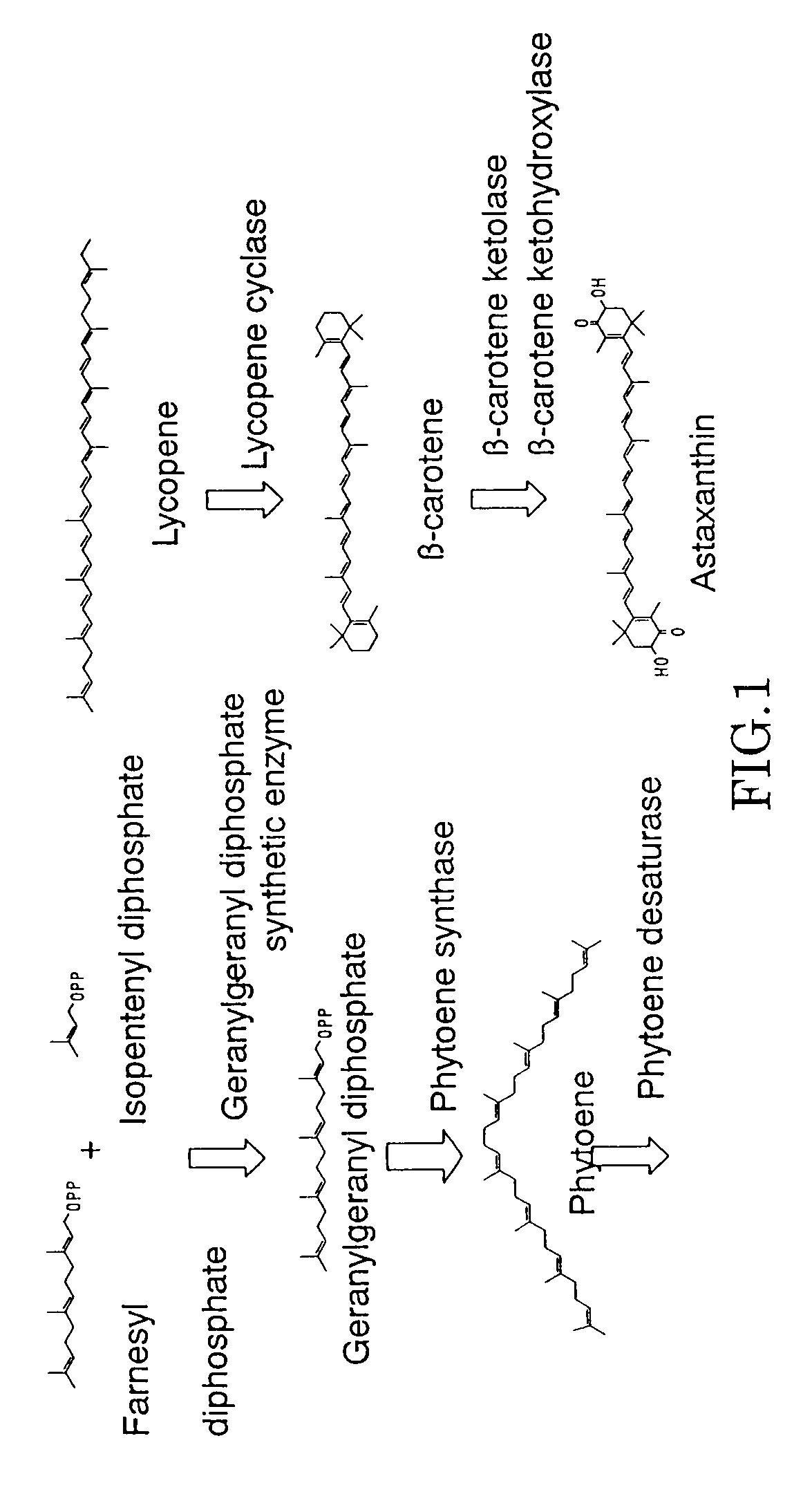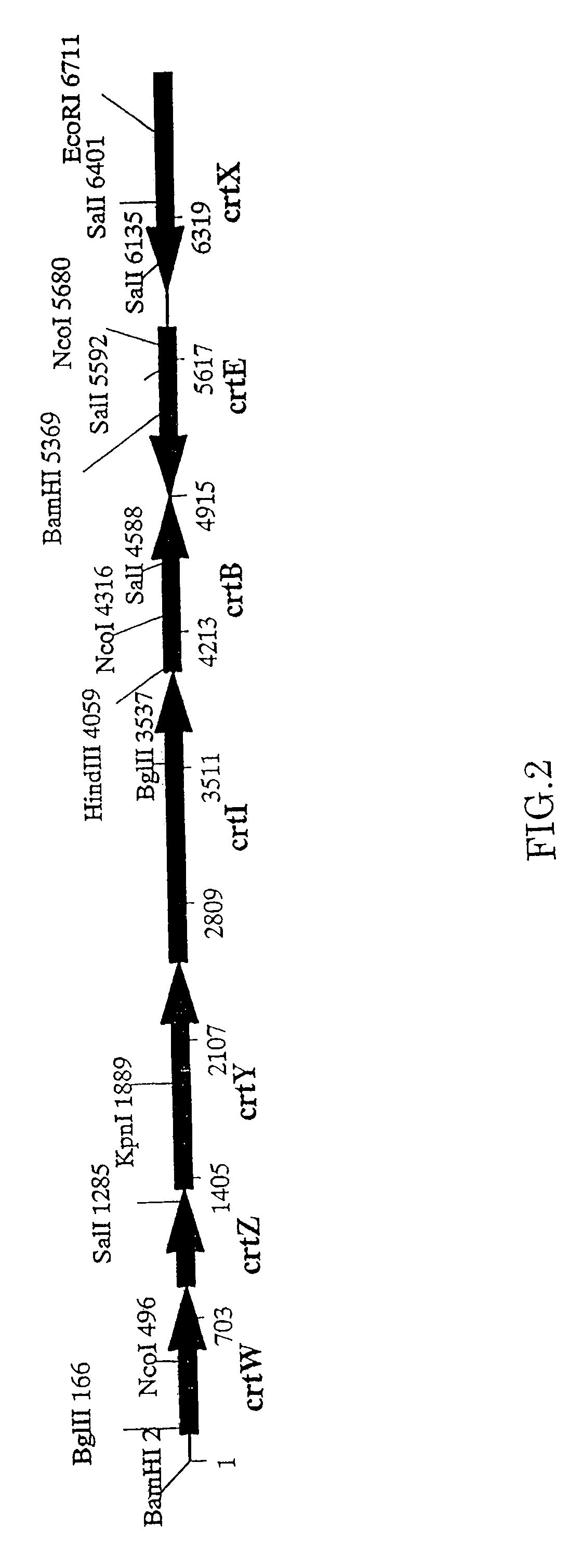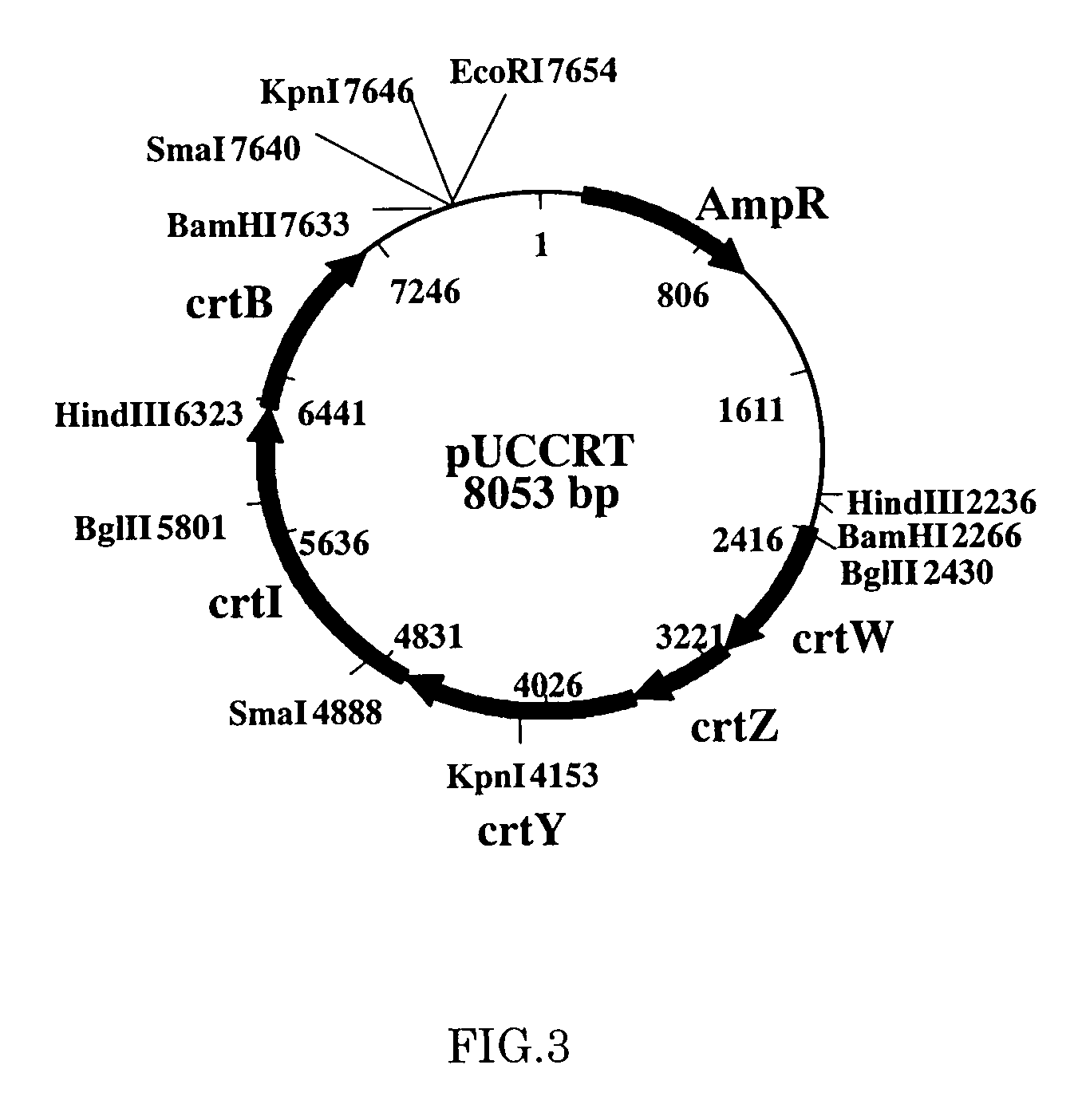Method for production of carotenoid-synthesizing microorganism and method for production of carotenoid
a technology of carotenoids and microorganisms, applied in the field of carotenoidsynthesizing microorganism production and carotenoid production methods, to achieve the effect of increasing reducing the amount of carotenoid
- Summary
- Abstract
- Description
- Claims
- Application Information
AI Technical Summary
Benefits of technology
Problems solved by technology
Method used
Image
Examples
example 1
Preparation of Genomic DNA Derived from Paracoccus Strain MBIC1143 and Cloning of Carotenoid Synthesis Gene
[0055]Paracoccus sp. strain MBIC1143 was cultured in an OEG culture medium (2 g / L of trypticase peptone, 1 g / L of yeast extract, 8.8 g / L of NaCl; 0.73 g / L magnesium sulfate heptahydrate, 3.6 g / L of anhydrous dipotassium phosphate, 1.4 g / L of potassium phosphate, 1 g / L of D-glucose) at 25° C. (rotary shaking at 120 rpm) for 3 days. Paracoccus sp. strain MBIC1143 was provided by Marin Biotechnology provided by Institute Co., Ltd.
[0056]A genomic DNA was prepared using a kit available from Gentra Systems, Inc. (Puregen Genomic DNA isolation kit) (about 50 ng / ml) Using the prepared DNA as a template, a carotenoid synthesis gene was amplified by PCR. Base sequences of genes (crtW, crtZ, crtY, crtI, crtB, crtE) constituting a group of carotenoid synthesis genes of Paracoccus sp. strain MBIC1143 are described in Non-patent document 2 and Patent document 3. Referring to these published ...
example 2
Preparation of Paracoccus Expression Vector
[0058]Plasmid vector pUCCRT was treated with a restriction enzyme BamHI, and a carotenoid synthesis gene fragment (about 5.4 k base) was obtained. Then the fragment was inserted into BamHI site in a broad-host-range vector pBBR1MCS2. Gene transduction into Escherichia coli strain JM109 was conducted by a heat shock method, and then transformation in a LB agar culture medium containing 50 μg / ml of kanamycin was conducted. An arbitrary transformant having acquired kanamycin resistance was cultured in a LB culture medium (37° C., 18 hours), and plasmid was extracted using a plasmid extraction kit (available from QIAGEN). Treatment of plasmid with a restriction enzyme BamHI demonstrated the presence of the intended insert. There are two orientations for insertion of the insert fragment. To be more specific, a vector in which transcription directions of lac promoter and insert fragment in the pBBR1MCS2 vector are the same (pBBR1MCS2CRT) and a ve...
example 3
Homogeneous Expression of Carotenoid Synthesis Gene in Paracoccus Bacteria
[0059]Each of the vectors pBBR1MCS2CRT and pBBR1MCS2CRTrv into which a carotenoid synthesis gene fragment was cloned was introduced into Escherichia coli strain S17-1 by a heat shock method, and transformation was effected in a LB agar culture medium containing 50 μg / ml of kanamycin and 10 μg / ml of streptomycin. An arbitrary transformant having acquired kanamycin resistance was cultured in a LB culture medium (37° C., 18 hours), and a plasmid was extracted using a plasmid extraction kit (available from QIAGEN) to check whether an objective plasmid was introduced. Then by treatment with a restriction enzyme BamHI, whether the plasmid was properly replicated in Escherichia coli strain S17-1 was checked. The two different plasmid vectors were respectively replicated without occurrence of recombination in Escherichia coli strain S17-1.
[0060]Escherichia coli strain S17-1 having the pBBR1MCS2CRT plasmid vector into ...
PUM
| Property | Measurement | Unit |
|---|---|---|
| melting temperature | aaaaa | aaaaa |
| melting temperature | aaaaa | aaaaa |
| temperature | aaaaa | aaaaa |
Abstract
Description
Claims
Application Information
 Login to View More
Login to View More - R&D
- Intellectual Property
- Life Sciences
- Materials
- Tech Scout
- Unparalleled Data Quality
- Higher Quality Content
- 60% Fewer Hallucinations
Browse by: Latest US Patents, China's latest patents, Technical Efficacy Thesaurus, Application Domain, Technology Topic, Popular Technical Reports.
© 2025 PatSnap. All rights reserved.Legal|Privacy policy|Modern Slavery Act Transparency Statement|Sitemap|About US| Contact US: help@patsnap.com



